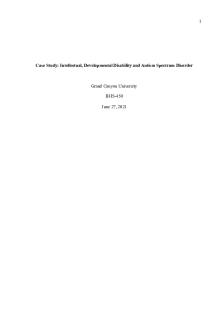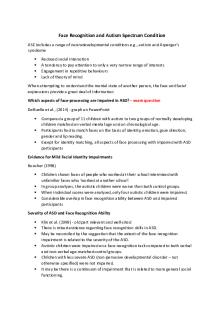Autism Spectrum Disorder Case Study PDF

| Title | Autism Spectrum Disorder Case Study |
|---|---|
| Author | Nika Garr |
| Course | Psychiatric Nursing |
| Institution | Miami Dade College |
| Pages | 5 |
| File Size | 95.4 KB |
| File Type | |
| Total Downloads | 48 |
| Total Views | 167 |
Summary
Clinical Case Study focused on Autism, This document is 100% completed...
Description
Case Study: Autism Spectrum Disorder
Seth, age 3, is the third child (and only boy) of Tom and Sue. He has been referred to a psychiatrist by their family physician at the request of the parents. Sue reports that she had a very difficult delivery of Seth, and he had needed oxygen at birth. Tom and Sue report that from the very beginning, Seth has been “different” from their other children, who have always enjoyed social interaction. Seth has tended to be aloof with a lack of response to social contact. When left with a babysitter, he often screams much of the time. His speech is limited and often confusing. For example, he often echoes words and phrases he hears or has heard. He may state, “Do you want to eat?” to indicate that he is hungry. His words are monotonistic and carry little, if any, inflection. He is fascinated by two things: objects that turn and music. He loves to listen to music and often dances in circles when listening. He has a favorite spinning top that he likes to carry around with him at all times. He is an expert at putting together jigsaw puzzles. He also likes to distribute kitchen utensils (particularly those with spinning parts) to various places around the house, and retrieval by Mom for their original use may precipitate temper tantrums lasting an hour or more, with screaming, kicking, and biting himself or others. Restoration of the status quo, playing his favorite music, or a long car ride is often the only way to interrupt these tantrums. The psychiatrist diagnosed Seth with Autism Spectrum Disorder. Answer the following questions:
1. Explain the etiology of Autism Spectrum Disorder.
Neurological, psychological, genetics and perinatal influences Autism spectrum disorder. Patient presents with deficits in social and communication interaction as well as your repetitive patterns of behavior interest and activity.
2. Provide clinical manifestations of this condition. What are the criteria of this condition according to the DSM-V? To meet diagnostic criteria for ASD according to DSM-5, a child must have persistent deficits in each of three areas of social communication and interaction (see A.1. through A.3. below) plus at least two of four types of restricted, repetitive behaviors (see B.1. through B.4. below). A. Persistent deficits in social communication and social interaction across multiple contexts, as manifested by the following, currently or by history (examples are illustrative, not exhaustive; see text): 1. Deficits in social-emotional reciprocity, ranging, for example, from abnormal social approach and failure of normal back-and-forth conversation; to reduced sharing of interests, emotions, or affect; to failure to initiate or respond to social interactions. 2. Deficits in nonverbal communicative behaviors used for social interaction, ranging, for example, from poorly integrated verbal and nonverbal communication; to abnormalities in eye contact and body language or deficits in understanding and use of gestures; to a total lack of facial expressions and nonverbal communication. 3. Deficits in developing, maintaining, and understand relationships, ranging, for example, from difficulties adjusting behavior to suit various social contexts; to difficulties in sharing imaginative play or in making friends; to absence of interest in peers. Specify current severity: Severity is based on social communication impairments and restricted, repetitive patterns of behavior. B. Restricted, repetitive patterns of behavior, interests, or activities, as manifested by at least two of the following, currently or by history (examples are illustrative, not exhaustive; see text): 1. Stereotyped or repetitive motor movements, use of objects, or speech (e.g., simple motor stereotypes, lining up toys or flipping objects, echolalia, idiosyncratic phrases).
2. Insistence on sameness, inflexible adherence to routines, or ritualized patterns of verbal or nonverbal behavior (e.g., extreme distress at small changes, difficulties with transitions, rigid thinking patterns, greeting rituals, need to take same route or eat same food every day). 3. Highly restricted, fixated interests that are abnormal in intensity or focus (e.g., strong attachment to or preoccupation with unusual objects, excessively circumscribed or perseverative interests). 4. Hyper- or hyperreactivity to sensory input or unusual interest in sensory aspects of the environment (e.g. apparent indifference to pain/temperature, adverse response to specific sounds or textures, excessive smelling or touching of objects, visual fascination with lights or movement). Specify current severity: Severity is based on social communication impairments and restricted, repetitive patterns of behavior. C. Symptoms must be present in the early developmental period (but may not become fully manifest until social demands exceed limited capacities or may be masked by learned strategies in later life). D. Symptoms cause clinically significant impairment in social, occupational, or other important areas of current functioning. E. These disturbances are not better explained by intellectual disability (intellectual developmental disorder) or global developmental delay. Intellectual disability and autism spectrum disorder frequently co-occur; to make comorbid diagnoses of autism spectrum disorder and intellectual disability, social communication should be below that expected for general developmental level. Note: Individuals with a well-established DSM-IV diagnosis of autistic disorder, Asperger’s disorder, or pervasive developmental disorder not otherwise specified should be given the diagnosis of autism spectrum disorder. Individuals who have marked deficits in social communication, but whose symptoms do not otherwise meet criteria for autism spectrum disorder, should be evaluated for social (pragmatic) communication disorder. Specify if: With or without accompanying intellectual impairment With or without accompanying language impairment Associated with a known medical or genetic condition or environmental factor (Coding note: Use additional code to identify the associated medical or genetic condition.) Associated with another neurodevelopmental, mental, or behavioral disorder (Coding note: Use additional code[s] to identify the associated neurodevelopmental, mental, or behavioral disorder[s]. With catatonia (refer to the criteria for catatonia associated with another mental disorder)
(Coding note: Use additional code 293.89 catatonia associated with autism spectrum disorder to indicate the presence of the comorbid catatonia.)
3. Develop a nursing care plan for this patient (Assessment, Nursing Diagnosis, Plan, and Intervention). Assessment- Observe for social deficits, including bonding with parents, dislike of cuddling, poor eye contact, and lack of interaction with peers. In addition, communication delays rigid routines and ritualized behaviors and interest maybe noted Nursing Diagnosis- Impaired verbal communication related to withdrawal into the self; inadequate sensory stimulation; neurological alterations Plan - Client will initiate social interactions (physical, verbal, nonverbal) with caregiver by time of discharge from treatment Intervention- Give positive reinforcement for eye contact with something acceptable to the child; Gradually replaced with social reinforcement. Assign a limited number of caregivers to the child; ensure that warmth, acceptance and availability are conveyed.
4. What treatments are available for this condition? Risperdal is the only drug approved by the FDA for children with autism spectrum disorder that can be prescribed for ages five through 16 years old to help with irritability. The most common side effects are drowsiness mild to moderate increase in appetite, nasal congestion, fatigue, constipation, drooling, dizziness and weight gain.
Applied behavior analysis is often used in schools and clinics to help the child learn positive behaviors and reduce negative. This approach can be used to improve wide range of skills. Sensory integrative therapy, it’s also used; if a child is easily upset by bright lights certain sounds or the feeling of being touched this therapy can help them learn to deal with that sensory information....
Similar Free PDFs

Austism Spectrum Disorder
- 4 Pages

Eating Disorder Case Study
- 4 Pages

Case Study 148 Panic Disorder
- 4 Pages

Autism
- 4 Pages

Nutrition Spectrum
- 3 Pages
Popular Institutions
- Tinajero National High School - Annex
- Politeknik Caltex Riau
- Yokohama City University
- SGT University
- University of Al-Qadisiyah
- Divine Word College of Vigan
- Techniek College Rotterdam
- Universidade de Santiago
- Universiti Teknologi MARA Cawangan Johor Kampus Pasir Gudang
- Poltekkes Kemenkes Yogyakarta
- Baguio City National High School
- Colegio san marcos
- preparatoria uno
- Centro de Bachillerato Tecnológico Industrial y de Servicios No. 107
- Dalian Maritime University
- Quang Trung Secondary School
- Colegio Tecnológico en Informática
- Corporación Regional de Educación Superior
- Grupo CEDVA
- Dar Al Uloom University
- Centro de Estudios Preuniversitarios de la Universidad Nacional de Ingeniería
- 上智大学
- Aakash International School, Nuna Majara
- San Felipe Neri Catholic School
- Kang Chiao International School - New Taipei City
- Misamis Occidental National High School
- Institución Educativa Escuela Normal Juan Ladrilleros
- Kolehiyo ng Pantukan
- Batanes State College
- Instituto Continental
- Sekolah Menengah Kejuruan Kesehatan Kaltara (Tarakan)
- Colegio de La Inmaculada Concepcion - Cebu










